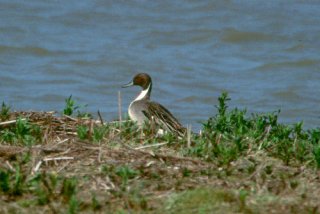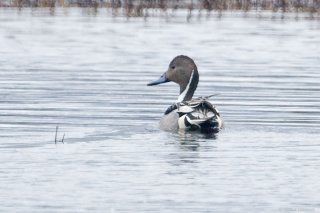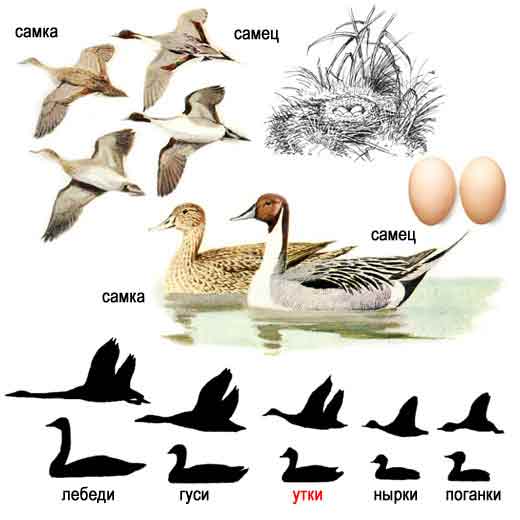Subfamily: Anatinae
Subgenus:
Anas - pintails
Anas
acuta, Northern Pintail,
No:
Stjertand
also picture
here
Anas eatoni, Eaton's Pintail,
No: Kerguelenand
Anas
eatoni eatoni,
Kerguelen Islands Pintail,
Anas
eatoni drygalskii,
Crozet Islands Pintail,
Anas georgica Yellow-billed Pintail, No:
Spisshaleand
Anas
georgica spinicauda, Chilean
Pintail,
Anas georgica
niceforoi, Niceforo's
Pintail, –
extinct (1950s)
Anas bahamensis, White-cheeked Pintail, No: Hvitkinnand
Anas
erythrorhyncha, Red-billed Teal, (formerly in Poecilonetta)
Anas capensis, Cape Teal, (formerly in Nettion)
|
Northern
Pintail,
Anas acuta, No: Stjertand
 © www.arthurgrosset.com
© www.arthurgrosset.com
The Pintail or Northern Pintail, Anas acuta, is a widely
occurring duck which breeds in the northern areas of Europe,
Asia
and North America. It is strongly migratory
and winters south of its breeding range to the equator. Unusually
for a bird with
such a large range, it has no geographical subspecies if the
possibly con-specific Eaton's Pintail
is considered to be a
separate species.
This is a fairly large duck, with a long pointed tail that gives
rise to the species' English and scientific names.
The Northern Pintail's many names describe the male's two long
black tail feathers, which in flight look like a single pin
or twig
(thus, the nickname sprig). These feathers are very distinctive,
accounting for a quarter of the total length of the drake when
in full plumage. Fast and graceful fliers, pintails are equipped
with long wings, small heads, and long necks that seem built
for
streamlined aerodynamics. Both sexes have blue gray bills and
gray legs and feet. The drake is more striking, having a thin
white
stripe running from the back of its chocolate-colored head down
its neck to its mostly white undercarriage. The drake also has
attractive gray, brown, and black patterning on its back and
sides. The hen's plumage is more subtle and subdued, with drab
brown feathers similar to those of other female dabblers. Hens
make a coarse quack and the drakes a flute-like whistle.
|
 I
flukt viser hannen, øverst på bildet, den svartgrønne
framsiden under vingen avgrenset i front av en bronsefarget stripe
I
flukt viser hannen, øverst på bildet, den svartgrønne
framsiden under vingen avgrenset i front av en bronsefarget stripe
, og fram til nakken av en hvit sktripe. Hunnen, nederst på
bildet, mangler disse kjennetegn.
© www.arthurgrosset.com
The Northern Pintail is a bird of open wetlands
which nests on the ground, often some distance from water. It
feeds by
dabbling for plant food and adds small invertebrates to its
diet during the nesting season. It is highly gregarious when
not
breeding, forming large mixed flocks with other species of duck.
This duck's population is affected by predators, parasites and
avian diseases. Human activities, such as agriculture, hunting
and fishing, have also had a significant impact on numbers.
Nevertheless, this species' huge range and large population
mean that it is not threatened globally.
 Northern
Pintail, Anas acuta, near Hodal in Faridabad District
of Haryana, India. November 2006
Northern
Pintail, Anas acuta, near Hodal in Faridabad District
of Haryana, India. November 2006
Photo: J.M.Garg http://en.wikipedia.org/wiki/File:Northern_Pintail_(Males)_near_Hodal_I_IMG_9252.jpg |
The Northern Pintail has been called the "nomads of the
skies." due to their wide-ranging migrations.
This dabbling duck breeds across northern areas of Eurasia south
to about Poland and Mongolia, and in Canada,
Alaska and the Midwestern United States. It winters mainly south
of its breeding range, reaching almost to the equator in
Panama, northern sub-Saharan Africa and tropical South Asia.
Small numbers migrate
to Pacific islands, particularly Hawaii,
where a few hundred birds winter on the main islands in shallow
wetlands and flooded agricultural habitats.
Transoceanic journeys also occur: a bird that was caught and
ringed in Labrador, Canada, was shot by a hunter in England
nine days later, and Japanese-ringed birds have been recovered
from six US states east to Utah and Mississippi.
In parts of the range, such as Great Britain and the northwestern
United States, the Pintail may be present all year.]
 Northern
pintail - overview
Northern
pintail - overview
Video: BBC Natural History Unit
Audio: Natural FX & Granada Wild
|
The Northern Pintail's breeding habitat is open unwooded wetlands,
such as wet grassland, lakesides or tundra.
In winter, it will utilise a wider range of open habitats, such
as sheltered estuaries, brackish marshes and coastal lagoons.
It is highly gregarious outside the breeding season and forms
very large mixed flocks with other ducks. |

© www.arthurgrosset.com
Breeding takes place between April and June,
with the nest being constructed on the ground and hidden amongst
vegetation
in a dry location, often some distance from water. It is a shallow
scrape on the ground lined with plant material and down.
The female lays seven to nine cream-coloured eggs at the rate
of one per day; the eggs are 55 x 38 millimetres in size and
weigh 45 grammes , of which 7% is shell. If predators destroy
the first clutch, the female can produce a replacement clutch
as late as the end of July.
The Pintail feeds by dabbling and upending in shallow water
for plant food mainly in the evening or at night, and therefore
spends much of the day resting. Its long neck enables it to
take food items from the bottom of water bodies up to
30 centimetres deep, which are beyond the reach of other dabbling
ducks like the Mallard.
The winter diet is mainly plant material including seeds and
rhizomes of aquatic plants, but the Pintail sometimes feeds
on roots,
grain and other seeds in fields, though less frequently than
other Anas ducks. During the nesting season, this bird eats
mainly
invertebrate animals, including aquatic insects, molluscs and
crustaceans.
All text for this bird: http://en.wikipedia.org/wiki/Northern_Pintail |
Kerguelenand,
Anas eatoni, Eaton's Pintail
 Eaton's
Pintail, Anas eatoni, Crozet Island, 19 April 2008
Eaton's
Pintail, Anas eatoni, Crozet Island, 19 April 2008
Photo: N. Hanuise
http://en.wikipedia.org/wiki/File:Anas_eatoni.jpg |
|
The Eaton's Pintail, Anas eatoni, is
a dabbling duck of the genus Anas. The species is restricted
to the island
groups of Kerguelen and Crozet in the southern Indian Ocean.
It resembles a small female Northern Pintail.
It was named after the English explorer and naturalist Alfred
Edmund Eaton.
It is threatened by introduced species, particularly feral
cats, which prey on them.
There are two subspecies:
Anas eatoni eatoni,
Kerguelen Islands Pintail,
Anas
eatoni drygalskii,
Crozet Islands Pintail,
|

Small, short-necked pintail. Resembles female Northern Pintail
A. acuta, but darker overall tone, more reddish-
brown, and scalloping on flanks smaller and less obvious. Male
has elongated central tail feathers and green speculum bordered
with white. Minority of males (1%) assume brighter breeding
plumage with trace of chocolate-brown on head and whitish stripe
up side of neck. The size is 40-45 cm.
Female has brown speculum bordered with white. Subspecies similar
but drygalskii slightly paler, more buff on breast, and
some birds show fine vermiculations on lower hindneck and flanks.
The population on the Crozet Islands was estimated at 600-700
pairs in 1980-1982 and on the Kerguelen Islands the
population was estimated at 15,000-20,000 pairs in 1982-1985
, although the numbers on the Kerguelen Islands could have
been much lower . The maximum estimate for the total population
in the early 1980s is therefore 31,200-41,400 mature
individuals, however the population is expected to have declined
significantly since).
 Anas
eatoni, Crozel Island
Source: © http://www.ipev.fr/pages/Crozet/faunecrozet.html
Anas
eatoni, Crozel Island
Source: © http://www.ipev.fr/pages/Crozet/faunecrozet.html |
It occupies small freshwater lakes, as well as pools, marshes,
peatbogs and streams, being more frequent on the coast in
winter where it is found in coastal lagoons, along the sea shore
and especially in sheltered bays.. It feeds on vegetation,
insects and crustaceans. Outside the breeding season, it occurs
in small parties, occasionally in concentrations of up to
200 birds on Kerguelen. The breeding season is from November
to the end of January or February and clutch size is
a minimum of five.
It was formerly much hunted by sealers and scientific expeditions,
with 200-300 shot each year after the establishment of
a base in 19501. Today, introduced predators are the greatest
threat on Possession, Cochons Island (Crozet) and the
Kerguelen Islands. On Kerguelen, feral cats may prove to be
a serious threat in the near future if petrels, their staple
prey,
reach low levels. The birds introduced to Amsterdam probably
disappeared owing to predation by feral cats and
brown rat Rattus norvegicus.
Source: BirdLife International
(2010) Species factsheet: Anas eatoni. Downloaded from http://www.birdlife.org
on 26/10/2010
|
|















